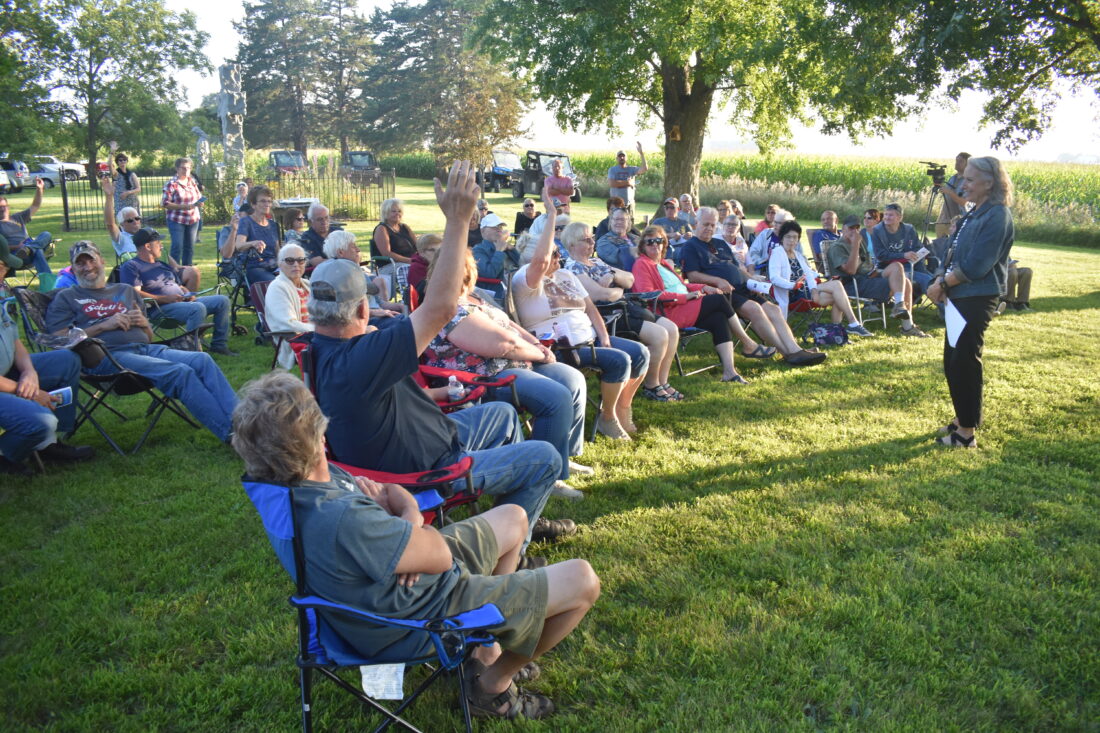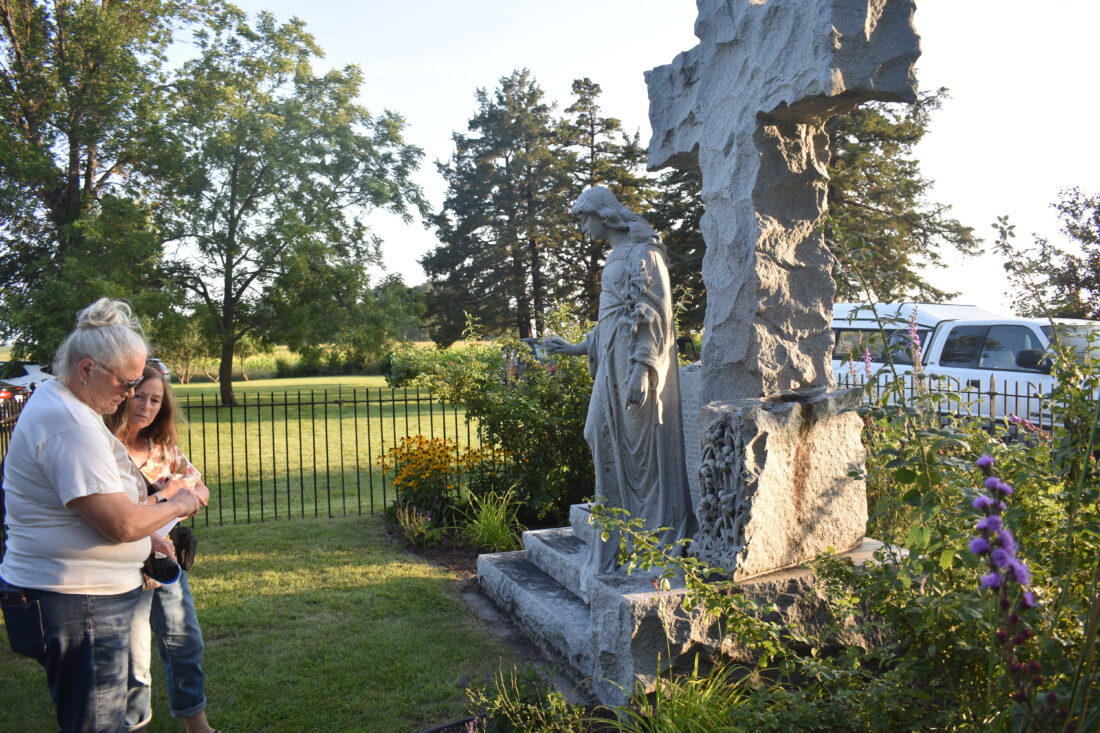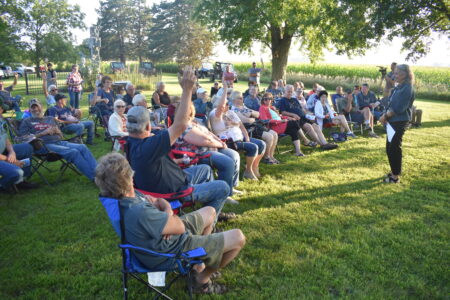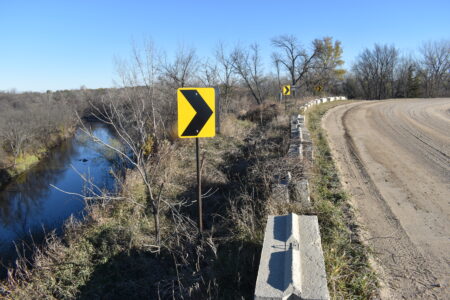Remembering U.S.-Dakota War
Milford Monument commemorated
- Several members of the audience for Lisa Besemer’s talk at the Milford Monument raised their hands when asked if they are related to any of the names of the memorial. The monument was erected to honor the lives lost in Milford Township on Aug. 18, 1862 during the start of the U.S.-Dakota War.
- Ann Seifert (right) and Shauna Moldan (left) read the names on the Milford Monument. Shauna Mondan is a descendent of the Henle family, many of whom died in in Milford on Aug. 18, 1862.

Several members of the audience for Lisa Besemer’s talk at the Milford Monument raised their hands when asked if they are related to any of the names of the memorial. The monument was erected to honor the lives lost in Milford Township on Aug. 18, 1862 during the start of the U.S.-Dakota War.
NEW ULM – On the Aug. 18, 1862 the Milford Township witnessed the start of the U.S.-Dakota War. By the end of that day, 52 people from Milford Township settlers were killed by attacking Dakota.
Today, a monument stands in the township memorializing those who were killed on the first day of the conflict. On Wednesday night, Lisa Besemer, a member of the Junior Pioneers, gave a speech on the history of the monument and about some of the people the monument was erected to honor.
Besemer said the original Milford Monument was placed on the site in 1912 by the New Ulm Junior Pioneers to commemorate the 50th anniversary of the conflict. Though the monument was placed in 1912, it would not be dedicated until 1914. The Junior Pioneer President at that time was Albert Steinhauser. During this dedication speech Steinhauser said the conflict would never have arisen if the government agents had treated the Dakota fairly and honestly. He believed the settlers were victims of conditions over which they had no control and were made to suffer for the fault and shortcomings of others.
Besemer said the original monument was unable to stand up to Minnesota weather and a replacement was needed after a few years. The Junior Pioneers asked the state of Minnesota to help fund the replacement.
A farmer living near the monument, Louis Spelbrink, was elected as a State Representative in 1918. He presented the legislature with an appropriation bill to fund a proper memorial. Unfortunately it was vetoed by the Governor. The re-submitted the bill again but was vetoed a second time. On the third try, the governor signed the appropriation bill that included $2,500 for the memorial.

Ann Seifert (right) and Shauna Moldan (left) read the names on the Milford Monument. Shauna Mondan is a descendent of the Henle family, many of whom died in in Milford on Aug. 18, 1862.
A monument committee was able to secure a stone rugged cross monument that was previously rejected by another family. The monument came with a fence for the cost of $2,385.
The rugged cross monument was made from Vermont granite. Besemer said it represents the stalwarts and hardy character of the pioneers and their strength, endurance and courage. The cross rests on three bases reading “faith, hope and charity”.
The new monument was placed Aug. 2, 1929 at its current site. The Junior Pioneers sold the one acre tot he State of Minnesota. The dedication ceremony for the monument was held in conjunction with the Diamond Jubilee of New Ulm’s founding. The dedication was attended by hundreds including then Governor Theodore Christiansen.
Besemer said the monument includes the names of all the people who died in Milford on Aug. 18, 1862. Those who died days later in the conflict, including those killed during the battles of New Ulm are not listed.
The second half of Besemer’s commemoration speech was dedicated the families with names on the monument. She provided a brief account of family farm sites in Milford that were attack on Aug. 18. Besemer said a much of the information about the Milford attack came from depredation claims made after the conflict. Many of pioneers submitted depredation claims to the U.S. government accounting for what was lost.
Besemer said that many of the farm sites from 1862 are no longer farms, but exist as tillable land. In 2009, Brown County Historical Society (BCHS) was awarded a grant to assist in the preservation and protection of the land which is considered an historic battlefield. The grant covered site mapping, archaeological study and National Register of Historic Places.
Besemer said some artifacts were found as part of the study, including charred wood from burnt out homestead. Near the land where the Zeller family lived with six children the head of a porcelain doll was uncovered.
Besemer closed the commemoration, saying the monument re-dedication keep the honor alive of the pioneers killed on that day.
Besemer’s presentation was the first in a series of U.S.-Dakota War commemoration events scheduled this week.
Thursday, Aug. 22, BCHS will hold a presentation at noon at museum annex on the St. Rose Academy: A Native American Boarding School.
Friday, Aug. 23 the annex will host a presentation at noon on Birch Coulee Battlefield.
Saturday, Aug. 24 the museum will host a book release and author talk for Nancy Silcox new book “A Place Called Home.” The book is historical fiction about a family coming to New Ulm and being caught up in the U.S.-Dakota War. From 11 a.m. to 3 p.m. Saturday, the New Ulm Battery will visit the Kiesling House.
Starting at 2 p.m. Sunday, Aug. 25 special cemetery walking tours will be held in the Pioneer section of the New Ulm Cemetery.





